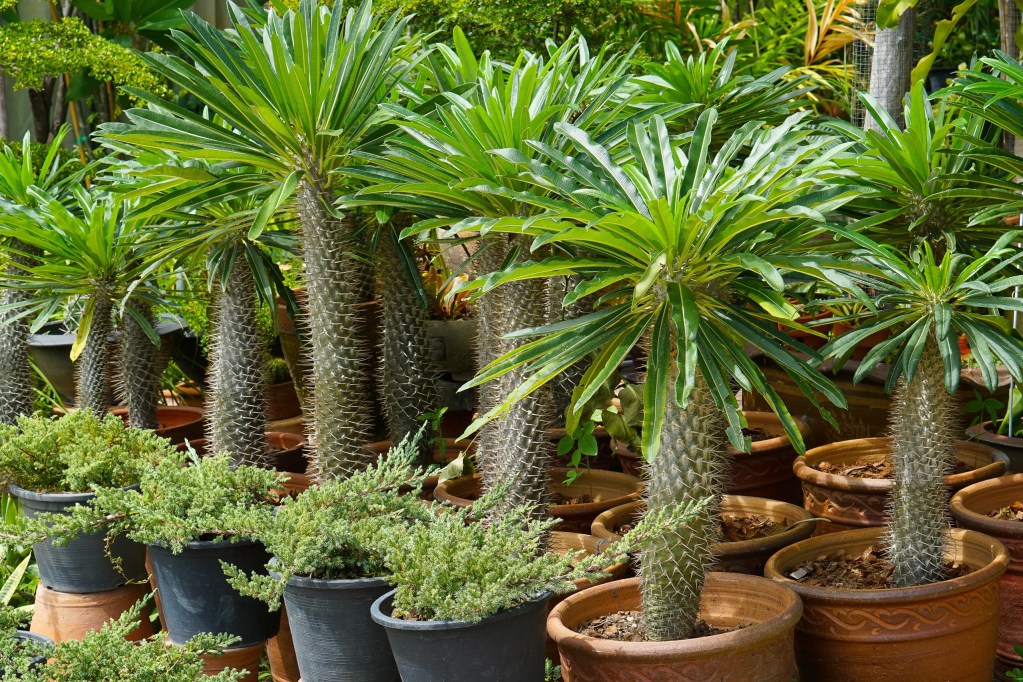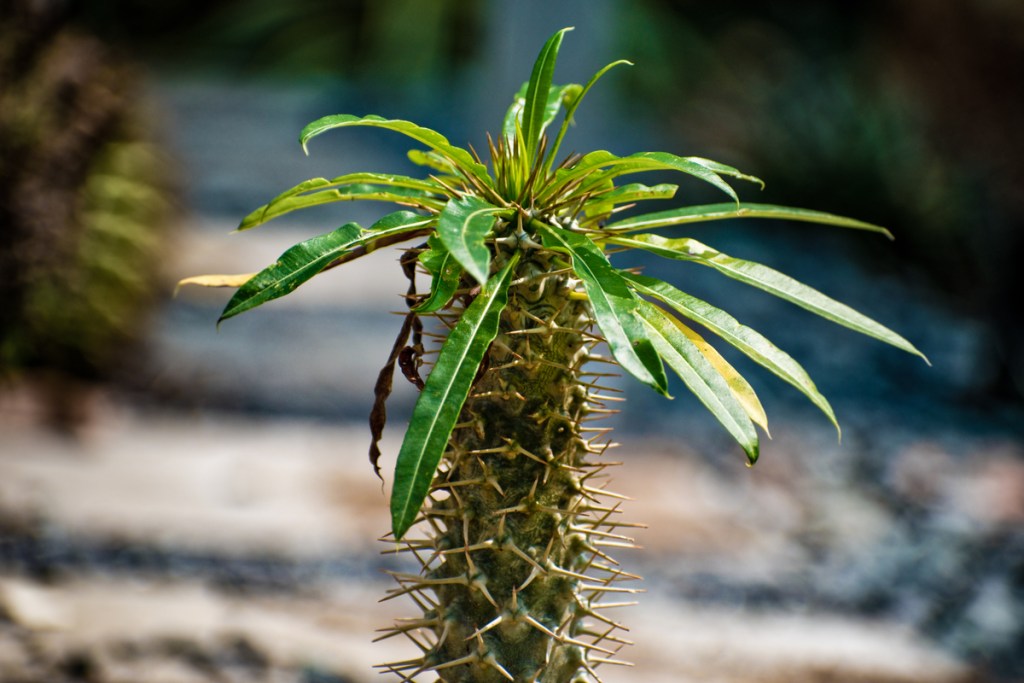For lush tropical vibes with a desert twist, the Madagascar palm tree (pachypodium lamerei) is the perfect addition to your space. It is one of the most exotic houseplants for your home. Technically, this plant is a succulent instead of a true palm, which means that it’s low maintenance in terms of watering and humidity needs. While the Madagascar palm thrives in full sunlight, it’s definitely suitable as an indoor houseplant if you give it adequate lighting. Before bringing this hardy plant into your house, let’s go over everything you need to know about Madagascar palm care.
As its name suggests, the Madagascar palm is a succulent plant native to southern Madagascar. It features a thick silver stem covered in sharp spines and long, leathery green leaves that grow on its top. Its trunk can reach up to 6 feet tall indoors and 20 feet tall outdoors. When grown outside, the Madagascar palm may also produce white trumpet-like flowers, but it rarely blooms when kept inside. Mature plants tend to branch out after flowering.

Madagascar palm care basics
The Madagascar palm doesn’t require a lot of extensive care. Here's what you need to know about its light, water, soil, temperature, and fertilizer needs, as well as what to do if you notice its leaves turning black.
Step 1: Like most succulents, this plant appreciates full sun, but it can tolerate partial shade outdoors as well. If you plan to keep your Madagascar palm indoors, make sure that it gets enough sunlight by placing it right next to a south- or west-facing window. Rotate your plant so that it receives sunlight evenly; otherwise, the plant may grow crooked as it reaches for sunlight on one side.
Step 2: The Madagascar palm prefers to stay dry, so keep it in a well-draining cactus potting mix inside of a pot with a drainage hole. Water your plant when the soil dries out completely and cut back on watering during the winter to avoid root rot. Keep in mind that your plant will likely go dormant during the winter, so don’t fret if leaves drop in colder months—they should grow back in the springtime.
Step 3: Make sure to place your Madagascar palm tree in an area with a temperature above 50 degrees Fahrenheit, as it does not tolerate frost. If you live in a cold region, bring your plant indoors if the outside temperature drops below 50 degrees Fahrenheit.
Step 4: At the beginning of spring and summer, feed your palm tree diluted liquid houseplant fertilizer to encourage growth.
Step 5: There are a lot of reasons the plant's leaves might turn black; it might be getting too much or too little water, or too much or too little light, or it even just be a healthy sign of the plant settling into a new environment. Losing leaves is a regular part of the plant's lifespan, so don't fret about a few black or dropped leaves here and there. If the problem seems excessive, dial back on the care: stop fertilizing, let the soil dry out between watering, and ensure that the plant is getting the light it needs.

How to repot a Madagascar palm
The Madagascar palm tree is a top-heavy plant with a thick stem and relatively small roots. While it’s a slow grower, it can topple over when it gets too big, so repot it approximately every three years or whenever it outgrows its current container. Important note: when it's time to move your Madagascar palm to a new pot, be careful around the plant's sharp spines. When it’s scraped or cut, the plant will release a toxic white sap that irritates the skin.
Step 1: When picking out a new home for your plant, consider a clay pot, which not only absorbs excess water but also balances a heavy plant better than a plastic planter.
Step 2: Fill the pot with cactus soil. If you're making your own potting mix, you can add perlite or sand for extra drainage if needed.
Step 3: If your plant is small enough, wrap cardstock or newspapers around it and pull it upward by the paper edges. Alternatively, use thick gloves for more control over the plant.
Step 4: While still being cautious around the spines, place the plant into the pot.

How to propagate a Madagascar palm
There are two main ways to propagate a Madagascar palm tree: via seeds or a shoot from the mother plant.
Step 1: The seed method is more difficult and time-consuming than propagation from an existing palm, but still doable. First, collect the cucumber-like seed pods from the upper branches of a mature plant and let the pods dry out for anywhere between a week to a month.
Step 2: Cut open the dried seed pods and collect the seeds.
Step 3: Soak the seeds in non-chlorinated water for roughly a day and then plant them in cactus soil. Don't worry if it seems like nothing happens for a while; it may take several months for a sprout to appear.
Step 4: The easiest way to propagate a Madagascar palm tree is to cut a shoot from a mother plant. Use a sterilized knife or pruning shears, and be sure to proceed with caution—our warning about the spines and sap still stands!
Step 5: Let the cutting callus over (i.e., form a hardened area over the spot where it was cut from the mother plant) for between four to eight days.
Step 6: Place the cutting into cactus soil and wait for new roots to form. Again, be prepared to wait as long as a few months for a new sprout to show up.
At the end of the day, treat your Madagascar palm like you would a cactus plant. Give it the opportunity to thrive with bright light, and treat its spines with caution. With plenty of sunlight and occasional watering, you’ll have a flourishing Madagascar palm for years to come.
Editors' Recommendations
- Everything you need to know about trailing succulents care for lush, thick growth
- How to pick the perfect orchid pots for healthy blooms
- Beyond basil and cilantro, add these unique plants to your indoor herb garden
- Beautiful, low-maintenance pothos varieties to add to your plant collection
- 5 easy-care spider plant varieties perfect for any home garden



